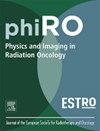低分割放疗中神经血管束保留与现实治疗的不确定性
IF 3.4
Q2 ONCOLOGY
引用次数: 0
摘要
背景与目的勃起功能障碍是前列腺癌放疗后常见的副作用。为了减轻这种毒性,有人建议限制对关键神经和血管的剂量。在现实治疗不确定性的影响下,探讨立体定向放射治疗中保留神经血管束(NVBs)的可行性。材料与方法对20例患者自动生成5 × 7.25 Gy非保留和保留NVB治疗方案。采用多项式混沌展开(PCE)快速准确地建立剂量与治疗误差的模型。PCE能够对每个方案进行100,000个治疗方案的稳健性评估,从而得出临床相关剂量体积直方图参数和人群剂量直方图的方案分布。结果在非共面(NC)和共面(C)方案存在实际治疗不确定性的情况下,患者人群NVB的中位D0.1cm3平均降低3.7 Gy和4.4 Gy。在平均V36.25Gy时,保留NVBs使计划靶体积覆盖率降低了2.1%,但临床靶体积(CTV)剂量仍然足够。人群剂量直方图显示,尽管节约确实影响危险器官(OARs)的剂量体积直方图参数,但超出规划约束的可能性有限。结论在治疗不确定性存在的情况下,保持nvb保留,不影响CTV覆盖或OAR剂量。NC和C两种方案获得的NVB剂量无显著差异。所达到的节约的临床影响是正在进行的临床试验的主题。本文章由计算机程序翻译,如有差异,请以英文原文为准。
Neurovascular bundle sparing in hypofractionated radiotherapy maintained with realistic treatment uncertainties
Background and purpose
Erectile dysfunction is a common side effect of radiotherapy for prostate cancer. To mitigate this toxicity, it has been suggested to limit the dose to critical nerves and vessels. We investigated the feasibility of sparing the neuro-vascular bundles (NVBs) in stereotactic body radiotherapy under the impact of realistic treatment uncertainties.
Materials and methods
Non-sparing and sparing NVB treatment plans, delivered in 5 × 7.25 Gy, were automatically generated for 20 patients. Polynomial Chaos Expansion (PCE) was used to fast and accurately model the dose against treatment errors. PCE enabled a robustness evaluation of 100.000 treatment scenarios per plan, allowing to derive scenario distributions of clinically relevant dose volume histogram parameters and population dose histograms.
Results
An average decrease of 3.7 Gy and 4.4 Gy in the median of the NVB was achieved in the patient population in the presence of realistic treatment uncertainties for non-coplanar (NC) and coplanar (C) plans respectively. Sparing NVBs decreased planning target volume coverage by 2.1 % in on average, however clinical target volume (CTV) dose remained adequate. Population dose histograms showed that, while sparing does impact dose volume histogram parameters of organs at risk (OARs), the probability of a scenario exceeding planning constraints was limited.
Conclusion
NVB sparing was maintained in the presence of treatment uncertainties without compromising CTV coverage or OAR dose. There was no significant difference in the achieved NVB dose between NC and C plans. The clinical impact of the achieved sparing is subject of ongoing clinical trials.
求助全文
通过发布文献求助,成功后即可免费获取论文全文。
去求助
来源期刊

Physics and Imaging in Radiation Oncology
Physics and Astronomy-Radiation
CiteScore
5.30
自引率
18.90%
发文量
93
审稿时长
6 weeks
 求助内容:
求助内容: 应助结果提醒方式:
应助结果提醒方式:


